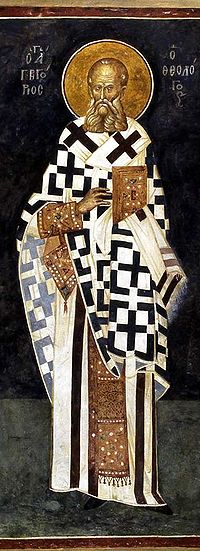Gregorius dari Nazianzus
Uskup Konstantinopel dari Nazianzus
Gregory dari Nazianzus (329 – 25 Januari 389) adalah uskup Konstantinopel pada abad ke-4. Gregory lahir di Arianzus, didekat Nazianzus, di Cappadocia barat daya.[1] Orang tuanya, Gregory dan Nonna, adalah tuan tanah yang kaya.
Santo Gregory dari Nazianzus | |
|---|---|
 Gregory | |
| Theologian, Doctor of the Church, Holy Hierarch | |
| Lahir | 329 SM Arianzum, Cappadocia |
| Meninggal | 25 Januari 389 Arianzum, Cappadocia |
| Dihormati di | Kristen Barat dan Timur |
| Kanonisasi | pre-congregation |
| Tempat ziarah | Katedral Patriarchal St. George di Fanar |
| Pesta | 2 Januari untuk gereja Barat; 25 Januari untuk gereja Timur; Katolik tradisional merayakan tanggal 9 Mei |
| Atribut | Mengenakan omophorion; memegang gulungan |
Daftar pustaka
- Michael Azkoul, "St. Gregory the Theologian: Poetry and Faith," Patristic and Byzantine Review 14.1–3 (1995): 59–68.
- Brian Daley, ed., Gregory Nazianzen. Early Church Fathers. London: Routledge, an imprint of Taylor & Francis Books Ltd., 2005. ISBN 0-415-12181-7. pp.192.
- K. Demoen, "Biblical vs. Non-Biblical Vocabulary in Gregorius Nazianzenus; a Quantitative Approach," Informatique 2 (1988–89): 243–53.
- J. Egan, "Gregory of Nazianzus and the Logos Doctrine," J. Plevnic, ed., Word and Spirit: Essays in Honor of David Michael Stanley. Willowdale, ON: 1975. pp.281–322.
- Anna-Stina Ellverson, The Dual Nature of Man: A Study in the Theological Anthropology of Gregory of Nazianzus. Acta Universitatis Upsaliensis, 1981. ISBN 91-554-1206-8. {Amazon.com}
- Gerald Fitzpatrick, "St Gregory Nazianzen: Education for Salvation," Patristic and Byzantine Review 10.1-2 (1991): 47–55.
- R.C. Gregg, Consolation Philosophy: Greek and Christian Paideia in Basil and the Two Gregories. Washington, DC: Catholic University of America Press, 1975. ISBN 0-8132-1000-3. {Amazon.com}
- Edward R. Hardy, ed. Christology of the Later Fathers, J. Baillie et al, eds. Library of Christian Classics, Vol. 3. Philadelphia: Westminster, 1995. Pbk. ISBN 0-664-24152-2
- Carol Harrison & Brian Daley (Editor). Gregory Nazianzen. Routledge, 1999. ISBN 0-415-12181-7
- V. Harrison, "Some Aspects of Saint Gregory (Nazianzen) the Theologian's Soteriology," Greek Orthodox Theological Review 34 (1989): 19–43/11–18.
- Susan R. Holman, "Healing the Social Leper in Gregory of Nyssa's and Gregory of Nazianzus's peri philoptochias," Harvard Theological Review 92.3 (1999): 283–309.
- M. Edmund Hussey,."The Theology of the Holy Spirit in the Writings of St. Gregory of Nazianzus," Diakonia 14.3 (1979): 224–233.
- Vasiliki Limberis, ."'Religion' as the Cipher for Identity: The Cases of Emperor Julian, Libanius, and Gregory Nazianzus," Harvard Theological Review 93.4 (2000): 373–400.
- George A. Kennedy, Greek Rhetoric Under Christian Emperors. Princeton: Princeton University Press, 1983. ISBN 0-691-03565-2. pp.215–239. {Amazon.com}
- N.B. McLynn, "The Other Olympias: Gregory of Nazianzen and the Family of Vitalianus," ZAC 2 (1998): 227–46.
- Ruth Majercik, "A Reminiscence of the Chaldean Oracles at Gregory of Nazianzus, Or. 29,2," Vigiliae Christianae 52.3 (1998): 286–292.
| style="width:50%; text-align:left; vertical-align:top;" |
- P.J. Maritz, "Logos Articulation in Gregory of Nazianzus," Acta Patristica et Byzantina 6 (1995): 99-108.
- E.P. Meijuring, "The Doctrine of the Will and the Trinity in the Orations of Gregory of Nazianzus," Nederlands Theologisch Tijdschrift 27.3 (1973): 224–234.
- Celica Milovanovic-Barham, "Gregory of Nazianzus: Ars Poetica (In suos versus: Carmen 2.1.39)," Journal of Early Christian Studies 5.4 (1997): 497–510.
- H. Musurillo, "The Poetry of Gregory of Nazianzus," Thought 45 (1970): 45–55.
- T.A. Noble, "Gregory Nazianzen's Use of Scripture in Defence of the Deity of the Spirit," Tyndale Bulletin 39 (1988): 101–123.
- F.W. Norris, "Of Thorns and Roses: The Logic of Belief in Gregory of Nazianzen," Church History, Vol. 53 (1984): 455–464.
- F.W. Norris, "The Tetragrammaton in Gregory Nazianzen (Or. 30.17)," Vigiliae Christianae 43 (1989): 339–44.
- F.W. Norris, Faith Gives Fullness to Reasoning: The Five Theological Orations of Gregory Nazianzen. Supplements to Vigiliae Christianae, Vol 13. Leiden: Brill, 1990. ISBN 90-04-09253-6. p. 314. {Amazon.com}
- Jay Wesley Richards, "Can a Male Savior Save Women?: Gregory of Nazianzus on the Logos' Assumption of Human Nature," Christian Scholar's Review 28.1 (1998): 42–57.
- K. Skurat, "St. Gregory of Nazianzus on Philosophy and Knowledge of God," Journal of Moscow Patriarchate 10 (October 1989): 57–62.
- Frank Thielman, "The Place of the Apocalypse in the Canon of St Gregory Nazianzen," Tyndale Bulletin 49.1 (1998): 155–157.
- Steven Peter Tsichlis, "The Nature of Theology in the Theological Orations of St. Gregory Nazianzus," Diakonia 16.3 (1981): 238–246.
- Raymond Van Dam, "Self-Representation in the Will of Gregory of Nazianzus," Journal of Theological Studies 46.1 (1995): 118–148.
- Kenneth Paul Wesche, "The Union of God and Man in Jesus Christ in the Thought of Gregory of Nazianzus," St. Vladimir's Theological Quarterly 28.2 (1984): 83–98.
- Donald F. Winslow, "Gregory of Nazianzus and Love for the Poor," Anglican Theological Review 47 (1965): 348–359.
- Donald F. Winslow, The Dynamics of Salvation: A Study in Gregory of Nazianzus. Cambridge, Mass.: North American Patristic Society, 1979. ISBN 0-915646-06-4.
- ^ Ruether, Rosemary Radford. Gregory of Nazianzus: Rhetor and Philosopher, (Oxford University Press, 1969), p. 18.